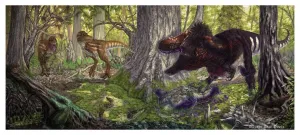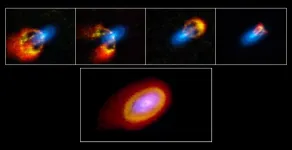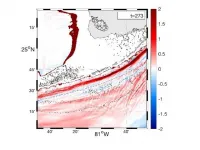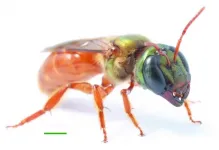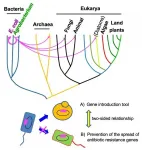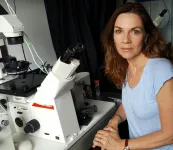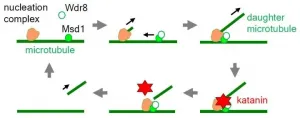(Press-News.org) New UMD study suggests that everywhere tyrannosaurs rose to dominance, their juveniles took over the ecological role of medium-sized carnivores
A new study shows that medium-sized predators all but disappeared late in dinosaur history wherever Tyrannosaurus rex and its close relatives rose to dominance. In those areas--lands that eventually became central Asia and Western North America--juvenile tyrannosaurs stepped in to fill the missing ecological niche previously held by other carnivores.
The research conducted by Thomas Holtz, a principal lecturer in the University of Maryland's Department of Geology, verified previous anecdotal reports of a dramatic drop-off in diversity of medium-sized predator species in communities dominated by tyrannosaurs. Diversity of prey species, on the other hand, did not decline. This suggests that medium-sized predators did not disappear because of a drop off in their prey, and that something else--likely young tyrannosaurs--stepped in to fill their ecological role. The study was published online on June 17, 2021, in the Canadian Journal of Earth Sciences.
"Earlier in the history of dinosaurs, in most communities you'd have a bunch of different types of carnivores of various size ranges from small fox-sized all the way up to the occasional giants," Holtz said. "Then something happens between 95 and 80 million years ago, where we see a shift. The really big carnivores, larger than an elephant, like tyrannosaurs and their kin, become the apex predators, and the middle-sized predators, say leopard to buffalo-sized carnivores, are either missing or very rare."
Typically, such a dramatic change in predators would coincide with some change in their prey. Either the prey species would increase dramatically in the absence of predators, or the prey species would also drop off, perhaps indicating why the predators disappeared. But the fact that Holtz found no shift in prey species diversity indicates that something continued to fill the ecological role of the missing middle-sized predators.
Previous work by Holtz and others provides evidence that young tyrannosaurs were faster and more agile than their parents and likely hunted prey more similar to that eaten by the faster, more agile medium-sized dinosaurs.
It is possible that as tyrannosaurs evolved and grew to dominance, their juveniles outcompeted other carnivorous dinosaurs in the middle-size range. But it is also possible that something else eliminated the other carnivores and tyrannosaurs simply stepped in to fill the gap. The shift to tyrannosaur dominance and the disappearance of middle-sized predators happened during a long gap in the fossil record, so scientists can't say exactly what occurred.
"Ultimately resolving that is going to rely on the most basic first-level aspect of paleontology, which is boots on the ground and picks in the sediments," Holtz said. "We need more sampling sites from this interval between about 95 and 80 million years ago."
To conduct the study, Holtz surveyed the existing record of 60 dinosaur communities--assemblages of animals living in the same area at the same time--from the Jurassic and Cretaceous periods (201 to 66 million years ago). First, he counted the number of carnivorous species and sorted them into size categories, with medium-sized dinosaurs weighing in at 50 to 1,000 kilograms and large dinosaurs exceeding 1,000 kilograms.
His analysis revealed that in 31 communities tyrannosaurs were not the largest predators, and there was a wide range of predators in the 50 to 1,000 kilogram category. In Asia and North America, those communities existed from the Jurassic through the early part of the late Cretaceous period (201 to 80 million years ago). Outside of Asia and North America, they continued to exist through the end of the late Cretaceous period (80 to 66 million years ago).
In the other 29 dinosaur communities Holtz surveyed, tyrannosaurs were the largest, and presumably dominant, predator weighing in at over 1,000 kilograms. In those communities, which were all found in Asia and North America, predators ranging from 50 to 1,000 kilograms were rare or absent during the latter half of the late Cretaceous period (80 to 66 million years ago).
Next, Holtz analyzed the same communities looking for shifts in the number of prey species. He found no statistical difference in prey species diversity between the tyrannosaur-dominated and non-tyrannosaur-dominated communities.
"So, what does this mean?" Holtz asked. "In those communities where middle-sized predators are gone but the prey species are just as diverse, can we say that no one is preying upon these middle-sized prey? No. That's almost certainly not the case. It is quite likely juvenile tyrannosaurs took over the ecological role of the missing middle-sized carnivores."
Future studies will drill deeper into the composition of prey species communities to see if there were changes in prey size during the shift to tyrannosaur domination. Holtz also plans to survey the size distribution of carnivores during the Triassic period from 251 to 201 million years ago. Understanding changes in size distribution and species diversity may help paleontologists understand the influences that affect different types of predator and prey communities.
"These interactions are important for understanding what life was like during the time of the dinosaurs," Holtz said. "But in the broader sense, having more understanding of changing ecosystems, and in this case, looking at the predator and prey components of an ecosystem, gives us a better and more diverse view of how the interactions of life work in the world, even today.
INFORMATION:
The research paper, "Theropod Guild Structure and the Tyrannosaurid Niche Assimilation Hypothesis: Implications for Predatory Dinosaur Macroecology and Ontogeny in later Late Cretaceous Asiamerica," Thomas Holtz, was published online on June 17, 2021, in the Canadian Journal of Earth Sciences.
Media Relations Contact: Kimbra Cutlip, 301-405-9463, kcutlip@umd.edu
University of Maryland
College of Computer, Mathematical, and Natural Sciences
2300 Symons Hall
College Park, Md. 20742
http://www.cmns.umd.edu
@UMDscience
About the College of Computer, Mathematical, and Natural Sciences
The College of Computer, Mathematical, and Natural Sciences at the University of Maryland educates more than 9,000 future scientific leaders in its undergraduate and graduate programs each year. The college's 10 departments and more than a dozen interdisciplinary research centers foster scientific discovery with annual sponsored research funding exceeding $200 million.
Like the movie version of Spider-Man who shoots spider webs from holes in his wrists, a little alpine plant has been found to eject cobweb-like threads from tiny holes in specialised cells on its leaves. It's these tiny holes that have taken plant scientists by surprise because puncturing the surface of a plant cell would normally cause it to explode like a water balloon.
The small perennial cushion-shaped plant with bright yellow flowers, Dionysia tapetodes, is in the primula family and naturally occurs in Turkmenistan and north-eastern Iran, and through the mountains of Afghanistan to the border of Pakistan. What makes it unusual is its leaves, which are covered in long silky fibres that ...
A team of scientists using the Atacama Large Millimeter/submillimeter Array (ALMA) to study the young star Elias 2-27 have confirmed that gravitational instabilities play a key role in planet formation, and have for the first time directly measured the mass of protoplanetary disks using gas velocity data, potentially unlocking one of the mysteries of planet formation. The results of the research are published today in two papers in The Astrophysical Journal.
Protoplanetary disks--planet-forming disks made of gas and dust that surround newly formed young stars--are ...
Ocean currents sometimes pinch off sections that create circular currents of water called "eddies." This "whirlpool" motion moves nutrients to the water's surface, playing a significant role in the health of the Florida Keys coral reef ecosystem.
Using a numerical model that simulates ocean currents, researchers from Florida Atlantic University's Harbor Branch Oceanographic Institute and collaborators from the Alfred-Wegener-Institute in Germany and the Institut Universitaire Europeen De La Mer/Laboratoire d'Océonographie Physique et Spatiale in France are shedding light on this important "motion of the ocean." They have conducted a first-of-its-kind study identifying ...
Researchers at the National Institutes of Health have developed a prototype device that could potentially diagnose pregnancy complications by monitoring the oxygen level of the placenta. The device sends near-infrared light through the pregnant person's abdomen to measure oxygen levels in the arterial and venous network in the placenta. The method was used to study anterior placenta, which is attached to the front wall of the uterus. The researchers described their results as promising but added that further study is needed before the device could be used routinely.
The small study was conducted by Amir Gandjbakhche, Ph.D., of the Section on Translational Biophotonics at NIH's Eunice Kennedy Shriver National Institute ...
People--who get lost easily in the extraordinary darkness of a tropical forest--have much to learn from a bee that can find its way home in conditions 10 times dimmer than starlight. Researchers at the Smithsonian Tropical Research Institute's (STRI) research station on Barro Colorado Island in Panama and the University of Lund in Sweden reveal that sweat bees (Megalopta genalis), find their way home based on patterns in the canopy overhead using dorsal vision. This first report of dorsal navigation in a flying insect, published in Current Biology, may be of special interest to makers of drones and other night-flying vehicles.
"One of the pioneers of studies on homing behaviors in bees was Charles H. Turner, an African-American scientist from the University ...
Bacteria do not sexually reproduce, but that does not stop them from exchanging genetic information as it evolves and adapts. During conjugal transfer, a bacterium can connect to another bacterium to pass along DNA and proteins. Escherichia coli bacteria, commonly called E. coli, can transfer at least one of these gene-containing plasmids to organisms across taxonomic kingdoms, including to fungi and protists. Now, researchers from Hiroshima University have a better understanding of this genetic hat trick, which has potential applications as a tool to promote desired characteristics or suppress harmful ones across genetic hosts.
They published their results on ...
Young people with poor mental health took a turn for the better during the pandemic but those with good mental health saw a considerable decline, new research reveals.
The first nationally representative evidence regarding the diverse impact of the COVID-19 pandemic on adolescent mental health in the UK was led by researchers at Lancaster University working with the University of British Columbia in Canada.
Adolescents (aged 10 to 16) with better than average mental health before the pandemic experienced an increase in their emotional and conduct problems, hyperactivity, and problems interacting with their peers and friends, but a decrease in their prosocial ...
Scientists have identified key molecular events in the developing human embryo between days 7 and 14 - one of the most mysterious, yet critical, stages of our development.
The second week of gestation represents a critical stage of embryo development, or embryogenesis. Failure of development during this time is one of the major causes of early pregnancy loss. Understanding more about it will help scientists to understand how it can go wrong, and take steps towards being able to fix problems.
The pre-implantation period, before the developing embryo implants into the mother's womb, has been studied extensively in human embryos ...
Ikoma, Japan - The katana, a Japanese sword, may be thought of solely as a weapon used by the samurai. But researchers from Japan have discovered that not only do plants wield their own katanas within their cells, they recruit them to specific locations within those cells to do their work.
In a study published in Nature Communications, researchers from Nara Institute of Science and Technology have revealed that the enzyme katanin, which is named after the katana, is used by an anchoring complex to cut microtubules at specific locations of the framework within individual plant cells.
Katanin ...
NEW YORK (June 17, 2021)--New York City neighborhoods that had higher levels of socioeconomic disadvantage experienced more COVID-19 infections and deaths, according to Mount Sinai scientists who created a neighborhood-level COVID-19 inequity index.
The index measured factors that fueled inequities in the residents' lives, such as employment and commuting patterns, population density of their neighborhood, food access, socioeconomic status, and access to health care. This allowed the scientists to compare between neighborhoods the contributions of these social factors in facilitating disease transmission during the first wave of the pandemic in a study published in Nature Communications in June.
"Much of the early rhetoric around COVID-19 ...
